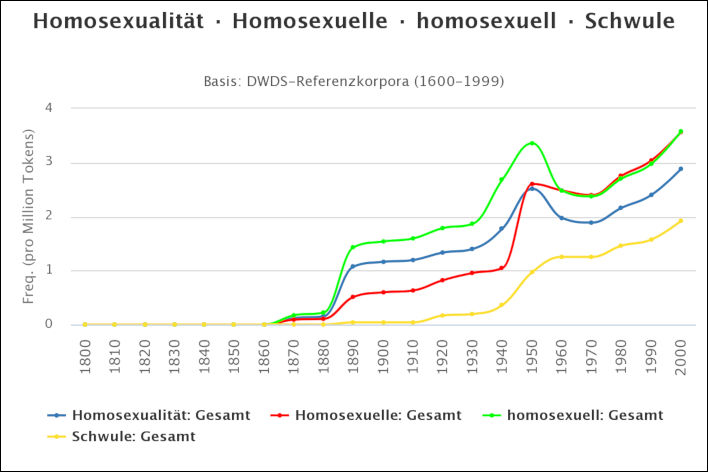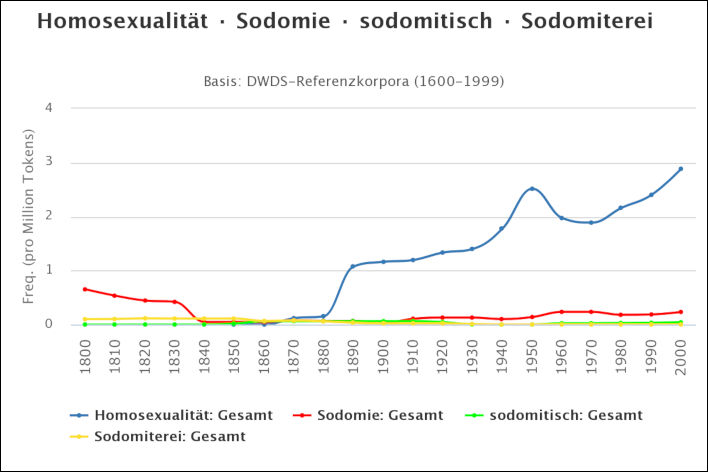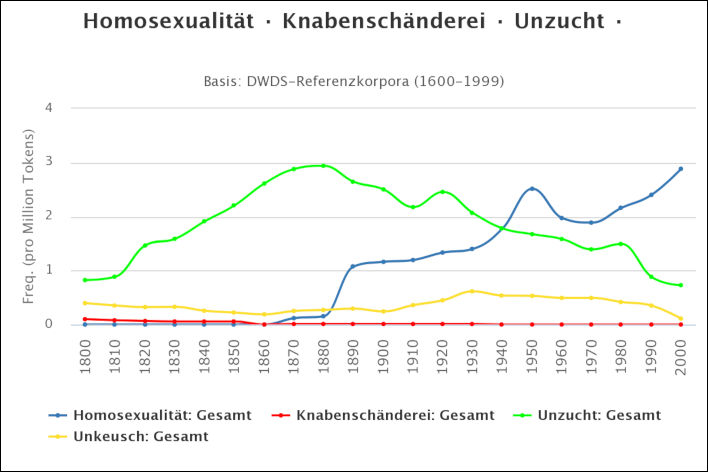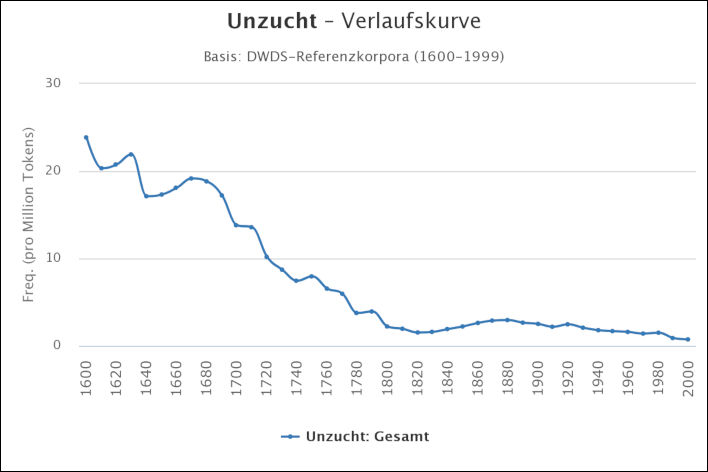Deviant deed or personality type?
Posted by Richard on UTC 2018-09-30 22:31
What's in a word
We can demonstrate some aspects of the cultural history of homosexuality using the excellent language research tools provided by Das Wortauskunftssystem zur deutschen Sprache in Geschichte und Gegenwart.
In the following frequency plots we have taken our starting point as 1800, although we could go back to 1600 with this system: our focus is upon the Biedermeier age around 1820 compared to the modern era of 2000. The graphs show the frequency of the occurrences of specific words in every million tokens (~sentences). The tokens are contained in a range of immense German text corpora constructed from many sources of real-world usage.
Just to get us started, let's look at the frequency of use of the word Homosexualität, 'homosexuality', and some of its variants:

The blue line is the frequency of occurrence in German of the word Homosexualität, the red and the green lines those of the two variants: Homosexuelle, the noun referring to a person (red) and homosexuell, the adjective (green). The yellow line represents the frequency of occurrence of the noun Schwule, a popular idiomatic appellation. [NB: The frequencies include all the declined forms for each word.]
It is obvious that the semantic field around 'homosexuality' first came into use in German around the mid-1860s. If this were an academic paper I would devote some pages to analysing in more detail the semantics of the actual usage of the words but life is short (and more importantly –unpaid).
Broadly speaking, this was the moment of the birth of the notion of a personality type that was identifiable as 'homosexual': that is, someone who can say 'I am what I am' not 'I am what I do'. We can trace the gradual recognition of such a personality type in the occurrence of the noun Schwule, which started its semantic career as a not very kind term for a homosexual man, but which over the years has become part of the accepted terminology of the subculture, in a similiar way to words such as 'gay' and 'queer' in English.
Before the 1860s the German language had no term for such a personality type and thus no concept of it. We can therefore say that homosexuality – the concept as we know it – did not exist before 1860.
There will be people now shouting at their monitors: just because the word didn't exist doesn't mean that the concept didn't exist. Yes it does. Just send me a postcard with a concept on it formulated without using language (natural or other). Assuming for the moment that you can have ideas without words, you may have some feeling or understanding in your head about something or other, but unless you can tell other people about it you are destined to have to keep it to yourself.
Well, of course, homosexual hanky-panky did not begin in 1860, but before that there was no personality type, no concept: there were merely deeds and proclivity to them. What words were used for these? Here are just three possibilities compared with Homosexualität: the noun Sodomie, the adjective sodomitisch, 'sodomitic' and the noun Sodomiterei, approximately 'the practice of sodomy'. Yes, I am aware that these are all pejorative words, but at that time few people had anything good to say on such matters – 'foreign country', remember?

Whereas after its introduction in the 1860s Homosexualität clearly became a topic of widespread discussion, the occurrences of words in the semantic field around Sodomie were much lower – certainly the introduction of the word Homosexualität with its abstract, clinical sterility eliminated much of the need for the anatomical precision of Sodomie. It is risky to draw conclusions at frequencies lower than 1 in a million tokens, so the puzzling absence of any mention of Sodomie between 1840 and 1910 and the continuing low frequencies thereafter have to remain puzzling.
The semantic field for Sodomie comes with a health warning: until relatively recent times the word encompassed many more fun activities than anal penetration, so it is not a perfect synonym for 'homosexual activity between men'. The ingenious inhabitants of Sodom and Gomorrah were not amateurs at wickedness – nor were Lot and his daughters, come to think of it.
An obvious reason for the low frequencies in this semantic field is that it contains words not used in polite society and therefore rarely written down. Not only were the words as indelicate as the acts they describe, but those acts at various times could lead to capital punishment, corporal punishment and/or long prison sentences.
Freedom to fumble
That said, there is another side to this coin that we must recognise: that is that, although a relatively limited range of acts, if discovered, could bring down horrible punishments on those involved, there was a great range of acts that were not criminal. They may not have been a topic of discussion over tea in respectable Biedermeier society, but two adult men discreetly having a fumble as 'consenting adults in private' had little to fear, even if the consent had been not quite as robust as it should have been.
Not just for men but also for children. Readers may remember the fate of Valentin Rosen, Franz Theodor Schubert's predecessor at the old Rossau school. The Catholic supervisors of the school were upset at Rosen's anti-clerical outbursts, openly and loudly expressed. They replaced him with the morally impeccable Schubert and demoted him to Schubert's former school in Himmelpfortgrund.
That they had received a large number of complaints about Rosen's inappropriate behaviour with the schoolchildren in his care (and with a number of adult women, too) was no impediment to taking up his new post as School Director in Himmelpfortgrund. Without penetration, nothing had taken place. There you are, you see: 'the past is a foreign country; they do things differently there'.
When we consider the situation today, in which even the most glancing touch on any part of the body can be interpreted as 'assault' or even 'sexual assault', we have to realise that all the easy-going freedoms of the Biedermeier age have been lost in our surprisingly repressive modern culture, a culture that in many ways is far more repressive and far more invasive than anything that Emperor Franz II/I, Prince Metternich or Count Sedlinitzsky could imagine. Our modern repressiveness in this respect may or may not be a good thing, but the easy-going Biedermeier attitude is difficult for young moderns to comprehend.
Unnatural acts
In politer discourse the place of the semantic field of Sodomie was taken by Unzucht, a word which could refer to an even wider range of 'unnatural' sexual acts involving sodomy, children, animals, or sexual acts done for money. Homosexual behaviour would tend to be assigned to this word, thus avoiding specifics:

The frequency of occurrence of the word Homosexualität compared with the word Unzucht. There was a little bit of Knabenschänderei, 'violating young boys' mentioned before 1868, when the word Homosexualität was invented. The variations in the use of this word and the related Kinderschänderei, 'violating children' are interesting, but wildly off-topic. We shall merely stir up our innner feminist by pointing out that whereas the word for violating boys comes into existence in 1680, and exists in some form until 1940, a comparable term for violating young girls seems never to have been needed (see our remarks above on the sex pest Valentin Rosen). The word Unkeusch, 'unchaste', which can cover many interesting activities (generally less serious than Unzucht) experienced a slightly surprising boom in the 20th century.
The word Unzucht has a long and interesting history. The frequncy of its occurrence shows a long decline (with a few blips) between 1600 and 1820. Investigating the reasons for this is beyond our scope, thank goodness. This curve is shown here to relativise the part of the curve in the previous graph: the pronounced peak in the 1800-2000 graph appears much gentler in the 1600-2000 graph of the word's occurrence.

The frequency of occurrence of the word Unzucht in the four centuries between 1600 and 2000.
The essence of all this graph plotting is that before the 1860s the German-speaking world used language that described deeds, not personality models. Thus, to speak of a 'homosexual' subculture at this time is not justified. Those deeds were looked upon with varying severity, but the times were much more religious than today (whether Protestant or Catholic) and the condemnation more heartfelt and more widespread.
There were no neutral, abstract or sterilised words. In the 1820s it would be very difficult to find someone prepared to shrug their shoulders and say 'so what?' over an accusation of sodomitic behaviour. It requires some effort on the part of moderns to recreate the religious feeling and the fear of divine retribution that were felt by our ancestors at what they saw as deviant practices. The first step in modern discussions, surely, is to avoid the use of the non-existent vocabulary of non-existent concepts. Let us instead look at the way one writer of the Biedermeier era handled the topic.
0 Comments UTC Loaded:
Input rules for comments: No HTML, no images. Comments can be nested to a depth of eight. Surround a long quotation with curly braces: {blockquote}. Well-formed URLs will be rendered as links automatically. Do not click on links unless you are confident that they are safe. You have been warned!